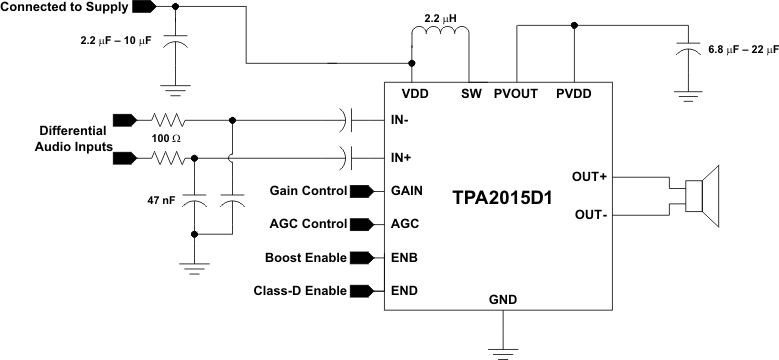SLOS638C November 2011 – June 2022 TPA2015D1
PRODUCTION DATA
- 1 Features
- 2 Applications
- 3 Description
- 4 Revision History
- 5 Device Comparison Table
- 6 Pin Configuration and Functions
- 7 Specifications
- 8 Parameter Measurement Information
-
9 Detailed Description
- 9.1 Overview
- 9.2 Functional Block Diagram
- 9.3 Feature Description
- 9.4 Device Functional Modes
- 10Application and Implementation
- 11Power Supply Recommendations
- 12Layout
- 13Device and Documentation Support
- 14Mechanical, Packaging, and Orderable Information
Package Options
Mechanical Data (Package|Pins)
- YZH|16
Thermal pad, mechanical data (Package|Pins)
Orderable Information
9.3.4 Operation With DACs and CODECs
Large ripple voltages can be present at the output of ΔΣ DACs and CODECs, just above the audio frequency (for example: 80 kHz with a 300 mVPP). This out-of-band noise is due to the noise shaping of the delta-sigma modulator in the DAC.
Some Class-D amplifiers have higher output noise when used in combination with these DACs and CODECs. This is because out-of-band noise from the CODEC/DAC mixes with the Class-D switching frequencies in the audio amplifier input stage.
The TPA2015D1 has a built-in low-pass filter that reduces the out-of-band noise and RF noise, filtering out-of-band frequencies that could degrade in-band noise performance. The TPA2015D1 AGC calculates gain based on input signal amplitude only.
If driving the TPA2015D1 input with 4th-order or higher ΔΣ DACs or CODECs, add an R-C low pass filter at each of the audio inputs (IN+ and IN-) of the TPA2015D1 to ensure best performance. The recommended resistor value is 100 Ω and the capacitor value of 47 nF.
 Figure 9-6 Reducing Out-of-Band DAC Noise With External Input Filter
Figure 9-6 Reducing Out-of-Band DAC Noise With External Input Filter